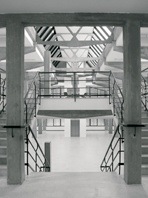Art Museum > Italy > Reggio Emilia
MARAMOTTI COLLECTION
COLLEZIONE MARAMOTTI

© Courtesy Collezione Maramotti
Via Fratelli Cervi 66
Reggio Emilia
ITALY
Contacts
Ph. 0039 0522 382484
Fax 0039 0522 934479
info (at) collezionemaranotti.org
www.collezionemaramotti.org
Opening hours
Thursday and Friday 2.30 - 6.30 pm
Saturday and Sunday 9.30 - 12.30 am/ 3.00 - 6.00 pm
Closed 1 and 6 January, 25 April, 1 May, from 1 to 25 August, 25 and 26 December
Entry: free
Visit: Only by booking on the phone or the Internet via the website. Entry without booking may be possible only if places are available. Only a maximum of 25 visitors are allowed for each visit.
Two possibilities are offered: the complete tour (for a total of 2:30 hours ) or the shorter one (for 1:15 hour)
1st floor, Italian and European art Forties to Eighties
2nd floor, European and American art from the Eighties to the present day
Guided tours are available on request for groups of at least 15 people.
Useful information:
Accessibility to the exhibition is provided for people with mobility impairment.
The visit to the exhibit entails the presence of collection personnel.
Children under 14 only if accompanied by adults.
Till the year 2000, several artworks were on display in the Max Mara factory in order to promote a daily and stimulating exchange between artistic creativity and industrial design.
The 29 September 2007 seen the opening – in the historical plant of Max Mara company, of the Maramotti Collection of international contemporary art from the second postwar period to the present day.
An important selection of two hundreds artworks in the Collection, comprising several hundreds works all together, is therefore offered on display to art connoisseurs and lovers, following the desire of the founder, Achille Maramotti.
Achille Maramotti passion for contemporary art has made it possible to create and develop a collection which comprises paintings, sculptures and installations dated from 1945 to the present day, which represent some of the most relevant Italian and international artistic trends of the second half of the 20th century. An additional source of interest is provided by the fact that the artists are represented here by important works in their earlier years, in the phases where their work introduced elements of novelty in the contemporary artistic research.
The permanent collection, on display on two floors in the old company factory in a layout comprising forty three rooms and two open spstarts with aces, several important European paintings representing the expressionist and abstract trends of the late Forties-early Fifties, defined as informal movement, and a group of Italian pre-conceptual works: Fontana, Burri, Fautrier, Manzoni. Followed by relevant groups of paintings from the so-called Roman Pop Art: Angeli, Festa, Schifano, Tacchi, of Arte Povera in its double Roman and Turin articulation: Kounellis, Boetti, Merz, Penone, Pistoletto, Zorio, Anselmo and Conceptual Art.
These works are followed by fundamental paintings of Transavanguardia – Cucchi, Chia, Clemente, De Maria, Paladino –, relevant examples of German – Kiefer, Baselitz, Polke, A.R. Penck – and American – Basquiat, Schnabel, Salle – new-expressionism; then we find a group of works of the New American Geometry from the Eighties-Nineties – Halley, Scully, Taaffe, Burton, Bleckner – and the most recent American and British experimentations with artworks by Ritchie, Gallagher, Barry X Ball, Sachs, Essenhigh, Craig-Martin, Maloney.
The works made in the 21st century, which are mostly not present in the permanent collection, will be displayed in thematic exhibitions on the ground-floor area, for temporary exhibition projects.
The constant exploration of expression languages which are constantly evolving in fashion and art was always the encompassing passion of Achille Maramotti, a passion finding its ideal continuity in the family’s decision to make of this place a “work in progress” displaying and testifying of new artistic trends.
The transformation of a production facility of fashion collections into an exhibition venue has been designed by keeping in mind the stark essentiality of the structure, which was conceived from the start as a flexible place capable of transforming itself according to changing needs.
In order to testify of the close relationship between Max Mara and the art world, the Collection will house and present the works awarded with the biennial Max Mara Art Prize for Women in collaboration with the Whitechapel Gallery, for emerging artists from Great Britain.
During the first opening months of the Collection the winning art work in the first edition of the prize (2006), and titled Ninna Nanna/Lullaby, made by video artist Margaret Salmon, was on exhibit.



